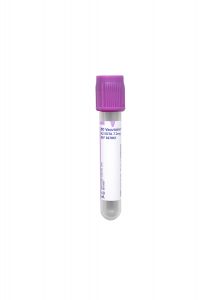Test Name
BK Virus Quantitation PCR, Plasma (BKQUAN)
CPT Codes
87799
Methodology
Polymerase Chain Reaction (PCR)
Turnaround Time
5 days
Specimen Requirements
Volume:
2 mL
Minimum Volume:
1 mL
Specimen Type:
Plasma
Collection Container:
Lavender BD Hemogard™ K2EDTA Tube
Transport Temperature:
Refrigerated
Stability
Ambient:
Unacceptable
Refrigerated:
5 days
Frozen:
30 days
Clinical Information
Reportable range is from 500 – 5,000,000 copies/mL
Reference Range
Negative for BKV DNA
Additional Information
Background Information
Acquired in childhood or adolescence, the polyomavirus (BKV) is one of a few polyomavirus infections that infect humans. The virus is spread from person to person and is most likely transmitted through the respiratory pathway.
Although its prevalence is high — 60 to 90% of people have antibodies to the BK virus — the infection usually remains latent, and individuals rarely demonstrate signs and symptoms. However, the virus is important in immunocompromised hosts, where reactivation of the latent infection causes disease.
This virus has emerged as an important cause of renal allograft infection (i.e. BK nephropathy). The BK virus also is associated with urethral stenosis, interstitial nephritis, and is one of the causes of hemorrhagic cystitis in bone marrow transplant recipients.1
The use of immunosuppressive drugs, which are necessary to prevent immunologic rejection of the renal allograft, has the side effect of increasing the likelihood of opportunistic infections. This immunosuppressed state affords the reactivation of a latent BK virus; and, if viral replication remains unchecked, then BK nephropathy will develop. It is estimated reactivation of the BKV occurs in 10 to 60% of renal transplant recipients, with anywhere from 1 to 5% developing BK nephropathy.2,3
Screening and early intervention for BKV have been a major advance over the past six to seven years and has led to an approximately eight-fold reduction in graft loss due to BKV. Most kidney transplant centers now employ BKV screening using quantitative BKV tests.
The presence of the BK virus may be assessed through a qualitative PCR of the urine. If the BK virus is present, then the quantity of the BK polyomavirus present is important. The higher the viral load in blood, the more likely the presence of renal disease. A progressive rise in serum creatinine concentration in a kidney transplant recipient, regardless of the underlying cause, should prompt a referral for reevaluation by the transplant center.
Treatment of BK nephropathy remains poorly defined. Most often, a decrease in immunosuppression is the therapy of choice, but this must be carefully balanced with the increased risk of renal allograft rejection.4
Clinical Indications
The BK virus most commonly produces asymptomatic infections; however, for patients with kidney and bone marrow transplants, BK virus infections are a cause of morbidity and mortality. Therefore, the quantitative BKV by PCR assay is indicated for renal transplant patients who are known to harbor the BK virus, particularly those with deterioration in renal function.
The assay is only to be used in patients with appropriate risk factors for BK-associated disease and is not indicated for the screening of asymptomatic patients.
International consensus guidelines have established the blood viral load of 10,000 copies/ml as a common threshold for intervention.5 In most patients, the quantity of the BK virus can be reduced with prompt restoration of BK virus-specific immunity, frequent monitoring, and timely modification or reduction of immunosuppression. According to an international consensus panel (Hirsch HH, 2005), monitoring for BK virus is recommended every three months for the first two years post-renal transplant or when allograft dysfunction occurs.
Methodology
Quantitative real-time PCR for the BK virus in the blood is currently the only noninvasive test for the measurement and monitoring of the BK viral load, which is important for the diagnosis and assessment of the treatment of BK nephropathy.
Interpretation
Results are reported in copies/mL of polyoma (BKV) virus. Detection of BKV DNA in clinical specimens supports the clinical diagnosis of renal disease due to BKV. The presence of BKV DNA in plasma at levels ≥ 10,000 copies BKV DNA/mL is specific for polyomavirus-associated nephropathy (PVAN).
Limitations
A negative result does not rule out the possibility of BK virus (BKV) infection; clinical correlation is necessary. Repeat testing at an appropriate interval may be needed.
References
1. WE Braun: BK polyomavirus: A newly recognized threat to transplanted kidneys. Cleveland Clinic Journal of Medicine. Dec 2003;1056-1068
2. Ramos E, Drachenberg CB, Papadimitrion JC, et al. Clinical course of polyoma virus nephropathy in 67 renal transplant patients. J Am Soc Nephrol. 2002;13:2145-2151.
3. Shah KV. Human polyomavirus BKV and renal disease. Nephrol DialTransplant. 2000;15:754-755.
4. S. Hariharn, Kidney International. 2006;69:655-662.
5. Hirsch HH, Brennan DC, Drachenberg CB, et al. Polyomavirus-associated nephropathy in renal transplantation: interdisciplinary analyses and recommendations. Transplantation. May 2005;79(10):1277-86

